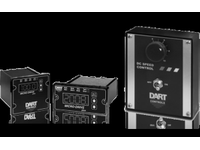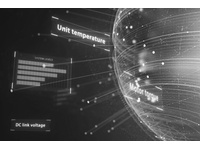Automation BY CATEGORY

Precision Gearhead
Utilized to increase torque while reducing speed in motor-driven systems, providing high levels of accuracy and efficiency within complex machinery.
Show Precision Gearhead
Counters, Meters & Timers
Instruments utilized to accurately measure various parameters in automation systems.
Show Counters, Meters & Timers
Controllers & PLCs
Integral components in automation systems used to govern the operation of machinery or processes based on programmed logic.
Show Controllers & PLCs
Tension Controls
Precisely monitors, regulates, and maintains consistent tension parameters in material processing operations.
Show Tension Controls
Industrial Networking
Hardware and software that facilitates communication protocols and network management.
Show Industrial Networking
Speed Controllers & VFDs
Control systems that adjust the speed and torque output of electric motors, providing energy efficiency and precise control.
Show Speed Controllers & VFDs
Stepper Systems
Show Stepper Systems
Sensors
Integral components that detect and measure physical and environmental parameters, providing crucial input for automated control processes.
Show Sensors
Industrial Fluid Controls
Devices used to manage and regulate the flow, pressure, and temperature of liquids or gases in automation systems.
Show Industrial Fluid Controls
Web Controls
Web-based interfaces and technologies to remotely monitor, control, and analyze automation systems and processes.
Show Web Controls
Fault Detection
Hardware and software devices utilized to identify and alert problems, malfunctions, or anomalies in automation systems to ensure safe and efficient operation.
Show Fault Detection
Servo Systems
Motors that utilize feedback from sensors to adjust performance parameters, enabling precise control of speed, position, and acceleration.
Show Servo Systems
Soft Start
Gradually ramps up the power supply when starting a motor, reducing the initial surge of current and stress on the motor.
Show Soft StartAutomation POPULAR PRODUCTS
Inovance IT7150E IT7000 series HMI 15 inch LCD screen 1024*600 resolution...
Brand Inovance
Model IT7150E
174308.00 DC SCR CONTROL NEMA 1 REVERSING 1PH .125-1HP/.25-2HP 115/230V
Brand Leeson
Model 174308.00
Inovance MD200S0.75B-INT MD200 Series VFD Voltage: 1PH 200-240Vac kW: 0.75...
Brand Inovance
Model MD200S0.75B-INT
Red Lion Controls PAXD0000 PAXD
Brand Red Lion Controls
Model PAXD0000
Inovance MD800-2-4T9R5S-INT MD800 Series Dual Output Drive Unit STO Voltage:...
Brand Inovance
Model MD800-2-4T9R5S-INT
Allen Bradley 1756-EWEB Enhanced Web Server Module ControlLogix
Brand Allen Bradley
Model 1756-EWEB

About Automation
Automation products are transforming industries by streamlining operations and boosting productivity. At MRO Supply, we provide cutting-edge industrial automation components designed to meet the demands of modern manufacturing and industrial processes.
Explore innovative solutions like servo motors essential for CNC machines, enabling precise control of movement in manufacturing and robotics applications. Enhance efficiency further with programmable logic controllers (PLCs), which deliver advanced control over automated processes, ensuring seamless integration and accuracy.
Our range includes industrial networking systems, facilitating real-time communication for predictive maintenance and reduced downtime. Additionally, fluid control systems such as valves, pumps, and sensors optimize flow and pressure management, ensuring safety and reliability in automated systems.
Partnering with industry leaders like Inovance, we offer innovative automation solutions to help you stay ahead. Whether you’re upgrading existing systems or starting fresh, MRO Supply has the expertise and components to transform your operations. Take the first step toward enhanced performance.
Inovance - Leaders in Automation
Inovance Software
Looking for Inovance drivers and software? Headover to our software portal by clicking the link below.
Inovance SoftwareInovance Spotlight Products
Founded in 2003, Inovance is a globally recognized leader in industrial automation solutions and components.
Inovance Spotlight ProductsInovance Servo Systems
Inovance Servo Systems deliver precise motion control and high performance, offering innovative solutions for industrial automation needs across various applications.
Inovance Servo SystemsInovance MD200 Series VFD
The Inovance MD200 Series VFD offers reliable and energy-efficient motor control, designed for versatility in industrial automation and optimized performance in diverse applications.
Buy MD200 Series OnlineAutomation BLOGS
View all blogsSoft Starters: A Closer Look at the Main Categories
Soft starters are devices used to gradually start and stop electric motors, reducing the mechanical stress...Industrial Automation - Your Comprehensive Guide
Industrial automation involves using control systems, such as computers or robots, and information...What is a PLC System?
Programmable Logic Controllers (PLC), also referred to as industrial computers, are crucial components for...Types of PLCs
Programmable Logic Controllers (PLCs) have become very crucial in defining and enhancing industrial...Automation ARTICLES

Alternative Protein Manufacturing and Automation
Demand is rising and employing automation and digital solutions are key to keeping up
READ MORE

What is the Advantage of AC Drive Compared to DC drive
Read more to discover the important factors to consider when deciding which type motor and control to use
READ MORE

Safety and Cybersecurity in Industrial Automation
The threat of cyber-attacks for manufacturers is real. The cost could be loss of money – or worse.
READ MORE

Condition-based monitoring with intelligent VACON® drives
The VACON® NXP and VACON® 100 drive series are now embedded with condition-based monitoring functionality.
READ MORE
Automation LITERATURE
SMV Frequency Inverter
The SMV range is designed for motor applications where dynamic speed and torque control is demanded, making the units ideal for conveyors, food production lines, packaging equipment plus fan and pump systems.
DOWNLOADTWMC Product Line Card
Motor Health Management products are the next generation of machine monitoring for any rotating equipment with anti-friction bearings.
DOWNLOADIndustrial AC/DC controls
The catalog contains the standard assortment of Leeson Industrial AC/DC controls
DOWNLOADInovance Software InoServoShop_V4.10.0.30
Inovance InoServoShop Software Bundle For v4.10.0.30
DOWNLOADInovance Software InoDriverShop_MDEN_3.7.1.28
Inovance Software Bundle For InoDriverShop_MDEN_3.7.1.28
DOWNLOAD













